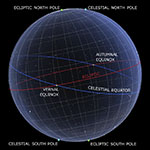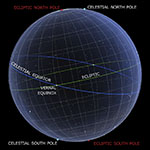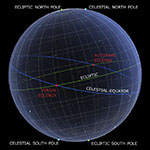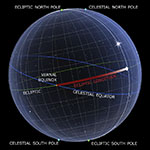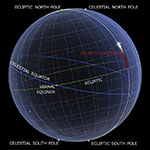Like the altazimuth coordinates and equatorial coordinates, the ecliptic coordinates are an orthogonal spherical reference system, i.e., in which the two series of circles selected to fix the position of a point on the celestial sphere intersect at right angles.
Since the system is based on celestial references, the ecliptic coordinates are, in a first approximation, linked to the fixed stars. This means that the two angles used to identify a celestial body— (ecliptic) longitude and (ecliptic) latitude—are identical for all terrestrial observers.
Of the three systems, ecliptic coordinates are those in longest documented use, owing to their convenience. As Claudius Ptolemy (2nd C. C.E.) notes in the Almagest, the precession of the equinoxes causes the celestial sphere to revolve very slowly around the ecliptic poles. For this reason, the ecliptic coordinates of a celestial body measured even very long ago can be easily updated by leaving the latitude unchanged and increasing the longitude by a quantity equal to the accumulated precession. Neither of the other two systems allows such a simple adjustment.
The main great circle of reference of the ecliptic coordinates, and the one that gives them their name, is the ecliptic. It corresponds to the Sun's annual path across the zodiac and is inclined to the celestial equator by an angle called obliquity, which today is equal to 23° 27'. In addition, the ecliptic intersects the celestial equator in the two diametrically opposite points of the equinoxes.
"Ecliptic" simply means "(oblique) circle" (in Greek ekklitiké, from klinein = to bend), which explains why the ecliptic coordinates were known in antiquity as the "system of the oblique sphere." Someone, however, has speculated that the term derives from eclipses (Greek ekleiptikós = pertaining to eclipses), given that these phenomena can occur only when the Moon, whose path is inclined by about 5° to the ecliptic, crosses the latter in a point corresponding to the position of the Sun (conjunction) or in a diametrically opposite point (opposition).
Since the shift from geocentric astronomy to heliocentric astronomy, "ecliptic" has also been used to refer to the plane of the Earth's orbit.
The main axis of reference used in ecliptic coordinates is the straight line passing through the observer and perpendicular to the plane of the ecliptic. It intersects the celestial sphere in two points: the north ecliptic pole and the south ecliptic pole.
The equinoxes are the two diametrically opposite points in which the ecliptic intersects the great circle of the celestial equator. Their name (from the Latin equam noctem = equal night) indicates that, when the Sun is at the equinox, day and night are of equal length. This happens on March 21, when the Sun, moving from the southern hemisphere of the celestial sphere to the northern hemisphere, appears in the vernal equinox (from the Latin vernum = pertaining to spring), and on September 22 or 23, when the Sun, returning to the southern hemisphere, appears in the autumnal equinox.
The vernal equinox is also called the vernal point and today, in astronomical jargon, the gamma point. If the ecliptic is divided into twelve zodiac signs of 30° each, the vernal equinox traditionally falls at the beginning of Aries (the Ram), whose astrological symbol resembles the Greek letter gamma (g).
The first of the two ecliptic coordinates is called (ecliptic) longitude. It is the angle, ranging between 0° and 360°, computed from west to east from the vernal equinox to the intersection between the ecliptic meridian of the celestial body and the ecliptic.
It should be noted that from antiquity to the modern age the ecliptic was customarily divided, starting from the vernal equinox, into twelve parts of 30° corresponding to the individual zodiac signs: Aries, Taurus, Gemini, Cancer, Leo, etc. For example, a longitude of 75° (= 30° + 30° + 15°) was referred to as 15° in Gemini, a longitude of 117° (= 30° + 30° + 30° + 27°) as 27° in Cancer, and so on. Although it ignores the progressive divergence between the sectors of the ecliptic and the zodiac constellations due to the precession of the equinoxes, this division is still used by astrologers today.
The second of the two ecliptic coordinates is called (ecliptic) latitude. It is the angle, measured along the ecliptic meridian of the celestial body, that separates the ecliptic from the body. The latitude ranges between 0° and 90°; the minimum and maximum values are reached on the ecliptic and at the ecliptic pole respectively. The latitude is positive or negative depending on whether the celestial body is located respectively to the north or to the south of the ecliptic.








